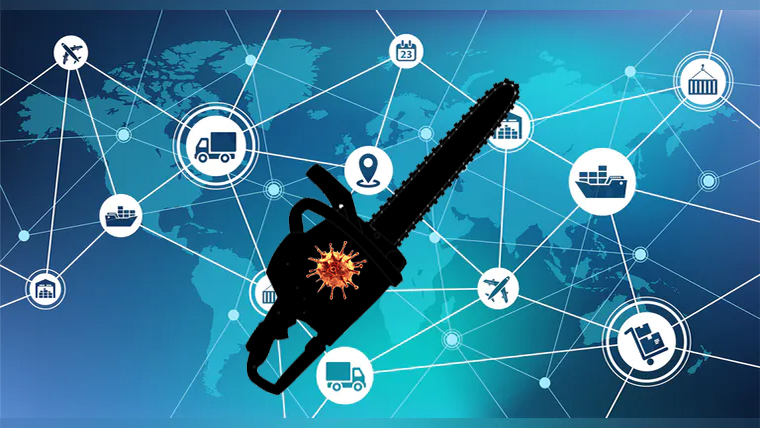
In the period leading up to the 2008 global financial crisis, a few prescient voices warned of potentially catastrophic systemic instability. In a famous 2005 speech, Raghuram G. Rajan explicitly cautioned that although structural and technological changes meant that the financial system was theoretically diversifying risk better than ever before, it might in practice be concentrating risk. At the time, Rajan was mocked; former US Treasury Secretary Larry Summers was not alone in thinking him a “Luddite.”
This episode comes to mind because of the widespread shortages emerging around the world. Markets for gas, truck drivers, carbon dioxide (extraordinarily), toys, ready-to-assemble furniture, iPhones, computer chips, and much else have been affected. Will these supply shocks prove merely a temporary disruption as the global economy recovers from the impact of the COVID-19 pandemic? Or are we instead witnessing a meltdown of the global production system? And in the latter case, what would be the supply-chain equivalent of leading central banks’ interventions to prevent a global financial collapse in 2008?
The parallels between today’s supply shocks and the 2008 financial shocks are striking. Prior to each crisis, the prevailing assumption had been that decentralized markets would provide adequate resilience, whether by spreading financial risks or ensuring a diversity of alternative supplies.
In the energy sector, for example, there has been a steady shift away from national self-sufficiency toward reliance on global markets. The European Union started the “liberalization” process in 2008, enabling new competition in gas and electricity in what was intended to be an EU-wide market. Although some had previously expressed concerns about the implications for security of supply, policymakers pressed ahead with legislation to entrust European economies’ energy imports to global markets.
But most analysts – and policymakers – failed to anticipate that the global markets for gas and many other commodities would turn out to have bottlenecks or gatekeepers. The supposed diversification of supply resulting from liberalization frequently seems to be illusory. For many products, including semiconductors or CO2 (a fertilizer by-product) for food processing, supplies have become more concentrated. And the splitting of global production chains into ever more specialized links over several decades has led to unexpectedly close correlations between supply shocks in different industries, as with fertilizer and food or semiconductors and cars.
In addition, some shortages (such as those of truck drivers and shipping containers, or gasoline in the United Kingdom) directly affect the logistics connecting the links in supply chains. As a result, vulnerabilities have rapidly become mutually reinforcing and self-amplifying. The global production system’s highly specialized, just-in-time design delivered substantial benefits, but its weaknesses are now evidently greater.
So, how should policymakers think about this lack of system resilience, and what can be done to counter it? Northwestern University’s Benjamin Golub has shown that queuing theory offers insights into how a small change in a well-functioning system (such as cutting two supermarket checkout lanes down to one) can lead to huge increases in wait times. Conversely, introducing a little slack into a system adds a lot of resilience.
Likewise, the classic cobweb model shows how time lags can destabilize markets and trigger large fluctuations in demand and supply. If demand is less responsive than supply to price signals, and expectations about the future prove incorrect, then a delay in suppliers’ responses drives volatility.
W. Brian Arthur’s famous El Farol Bar problem, which combines decisions made over time and the need to form expectations, produces a similarly unstable outcome. And as McKinsey & Company’s Tera Allas has pointed out, system dynamics was invented to think about supply chains as complex, non-linear dynamic systems.
So, there are plenty of mental models for understanding the current shortage problem. The pressing challenge is how to restore stability and ease the shortages so that people are not facing a holiday season with no toys, turkeys, or gas.
A top priority is to have better data and better business intelligence in government. Even after 30 years of globalization, there is astonishingly little detailed, publicly available information on product flows in global supply chains. Ministries need to restore the kind of engineering-based industry knowledge that was more common back when industrial policy was considered a key government function.
But in the short term, decentralized markets and price signals are the problem, not the solution. Governments will need to step in – whether by deploying soldiers to drive gasoline tankers or providing production subsidies – to mitigate some of the shortages.
When the immediate supply concerns abate, firms and policymakers must consider what kind of insurance or slack they should build into the production system over the longer term. Just as banks needed to increase their equity buffers after 2008, we perhaps now need to step back from just-in-time production and redefine productivity in light of supply-chain risks.
Diane Coyle, Professor of Public Policy at the University of Cambridge, is the author, most recently, of Markets, State, and People: Economics for Public Policy. This content is © Project Syndicate, 2021, and is here with permission.
16 Comments
It's sexier to paint the worst case scenario but the reality is that many many companies are moving production out of China and that's causing a hiccup in deliveries while they set up in India, Vietnam, Thailand, Malaysia, etc and even back to the US. Then you had the Ever Given silliness, the traffic jam at many ports where too many ships are waiting to unload, and thus here we have the current shortages.
These shortages don't come from a lack of supply, but instead bottlenecks which will be relieved eventually. As with many things, the situation will correct itself eventually, especially once we've moved past Covid.
Um, not so fast. AB5 in California wiped truck owner-operators, and the Climate Crew mandates trucks newer than 2010. Immediate effect on the container flow from West coast ports. Reference...
These new legislative bottlenecks just won't disappear or resolve over time. Lots more pain to come.
Just one small example of the sand increasingly being tipped into the gears of logistics chains....
"When the immediate supply concerns abate, firms and policymakers must consider what kind of insurance or slack they should build into the production system over the longer term."
And that (incorrectly IMO) assumes there is any slack able to be accommodated....demand has been promoted such that there is little (or no) capacity to absorb either the resource or financial costs without reducing overall demand.....and that is the death knell for the model
These issues and problems aren't just linked to business management failures and planning inadequacies, the parameters for such failures are often set by policy delivered by politicians with little real world experience educated increasingly in woke culture that has little prepared them personally or collectively for the real world . This is compounded by increasingly expecting more growth from a finite world from which resource extraction and availability is being pushed to its limits and probably beyond them .
Kanban is the opposite of what is wanted IMHO - it is the hallmark of lean and just in time, which is part of why we are having these issues. Kanban is not forward looking, just reactive. Works really well with smoothed end user demand (like Toyota does) but not good for volatile or seasonal demand
The only pressure I'm really worried about is Greenflation. As China cleans up messy industries we will re-import the emissions we exported to them over the last three decades. The fact neither the public nor private energy sector are accelerating renewable projects in the pipeline probably means higher prices are here to stay.
The combination of legislative pressure pushing users towards certain energy resources, and the 'liberalisation' of the the market for those resources, will, I believe, be a massive inflationary push from now on. We're already seeing it in carbon credits. Those who have the ability to corner the market at the right time will charge as much as the market can bear. Very stagflationary, while a few make out like bandits.
Excess demand loaded on by gov and CB huge influx of Qe and fiscal stimulus, onto and into last minute supply chains 3-9000 miles long. What could go wrong? We have got ourselves into an utterly unresilient state of dependency and built in obsolescence. Production increase and indulgence is not meeting real human needs and CV19 has led a lot of people to reassess priorities

We welcome your comments below. If you are not already registered, please register to comment.
Remember we welcome robust, respectful and insightful debate. We don't welcome abusive or defamatory comments and will de-register those repeatedly making such comments. Our current comment policy is here.